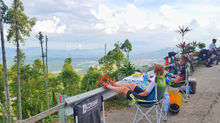Bolu Market: The Biggest Buffalo Market in Asia
- TOSA
- Nov 30, 2017
- 5 min read

Clueless buffalos enjoying their lunch without being interrupted by men.
While Thailand and Vietnam has its floating market, but Toraja also has one public attraction that caught the travelers' eye around the world: Bolu Market. I know you have heard about this Bolu market many times, but I think something popular isn't conceivable to be read only once, right? We would like to give you full exposure about Bolu Market, the biggest buffalo market in Asia and other things you could find in this market.
If you arrive in Rantepao, you may rent a motorcycle for approximately IDR 85,000 to IDR 150,000 for a half day. (prices vary according to low and high season). Then if you just need to drive down to Poros-Palopo road from the centre and it only takes less than 15 minutes to get to Bolu Market.
But if you like to choose the conventional way by using public transportation, you can see the blue car from the inner ring road 'Kandean Dulang'. There you pay around IDR 4,000 when you arrive in Bolu market.
From there, let us give you an insight what's like to be in this market:

An open-square, the market was nearly closed as it already hit 1.30 pm.
With green-bluish mountain in the background, you'll find a wide open-square with roof tenants at one side, where the locals bring their best buffalo in terms of selling and showing it off with others, as if it may be seen as social status in the society. To see this you need to go to buffalo market on the "Market Day" or in Indonesian it's called by "Hari Pasar", which is known where people bring their buffalos and pigs, only occurs on Tuesday and Saturday each week. It opens from 8 AM and closes around 2 or 3 PM. Locals usually don't need to pay for entrance fee, but tourists may need to pay for IDR 20,000.
Not an Ordinary Buffalo
Villagers from both around the area, and far away come to sell and buy their Water buffaloes and pigs, most of them to be sacrificed in their bizarre funeral ceremonies.This is not small business, believe me! . Small black buffaloes cost less than IDR 10 million whereas a big one will be around IDR 25 million. Cost will increase if is a stripe buffalo (Tedong Bonga) , but only wealthy families can afford an Albino or White Water-buffalo which can cost as much as IDR 500 million to 1 billion.

Tedong saleko
1. Tedong Saleko The most expensive buffalo in Toraja as it may reach IDR 1 billion, normally IDR 500 million when there's high demand. That could buy you a landed house! You could see from its albino skin, combined with white and black stripes with its ivory horns and white eyes.
2. Tedong Bonga
The appearance is pretty much alike with Tedong Saleko, but this variety has its color-base in black with white stripes.The price of this buffalo is just as close with Tedong Saleko, pretty much varies from IDR 300 million to IDR 500 million.

Lotong Boko
3. Lotong Boko This buffalo is very rare, but we were just in time when we saw this variety up on the pick-up truck. Still, it costs nearly IDR 1 billion. As you can see, the buffalo has its white skin, with big black stripe covering its back. Just as I heard today when one of my friend had a funeral ceremony where her home village offered 11 buffalos, one of them is Lotong Boko. One million rupiah is gone away for Torajanese funeral.
4. Tedong Sokko
We didn't get the chance to find this buffalo in Bolu market, but if you have seen along the road a black buffalo with both horns circulating backward under its neck. Not your ordinary buffalo too as it costs around IDR 100 million. Then, if it has white stripes on its body, price will go up above IDR 100 million.

Tedong Pudu' is taking some rest before going home.
5. Tedong Pudu'
A common buffalo which we can see almost everywhere. Aside it's usually used to be sacrificed in funerals, but locals usually have this kind of buffalo in bull fights since some buffalo have strong muscles and wide chests.
There are many other varieties of Torajanese buffalos, such as Tedong Todi', Tedong Tekken Langi', Tedong Ballian, Tedong Bulan, and Tedong Sambao'. Unfortunately, not all buffalos gathered at once when we were there as some are pretty rare at the moment. But it was such an insightful tourism of Toraja, where an ancient tradition is being held until now and yet some tight competitions are put in between. You could imagine when most of the funeral are happening (usually in June to August and December), the prices are going higher than ever.
Torajanese local crafts
Don't go home too quick, you need to explore another side of Bolu market. If you go on other way to the main road, you will see alleys between vegetables and coffee sellers. This side offers different ambience compared to the buffalo market. Bolu market aren't known for only selling vegetables and buffalo, but also for its bamboo and stone handicrafts, souvenirs, and other stuffs like second-handed goods.

At first, I used to think the rope is often used as a belt, but locals use it to tie the bamboo bag onto their head,
so they can carry it whenever going to harvest the rice.

At this complex in Bolu market, you can see handyman weaving hand-balls made from bamboo string,
One block usually consists of one family relative.

What was it for? To cut the rice stem, each for IDR 10,000.

All the handicrafts looks very chic to be placed in your kitchen or living room, especially in this current trend where hand-made home furnitures are favorable. Some of the products are made in northern part of Lolai and some are made in Sangala'. If you're having traditional family dinner and having all of your guests to sit on the floor, then you may just need a bamboo mat. In this area, it costs you from IDR 130,000 to 400,000, depending on the size. The locals made it for about 2-3 weeks for each mat.

Cheap goods, you can bargain some products, but some vendors may persist to not bargain.

The outdoor butcher shop - fresh buffalo coming from the outside!
As the rain started to pour, we were heading our way back to the city, while vendors started to put their stuffs back and closed their tenants. According to what this Bolu market has, you need to at least spend half of your day exploring this market. Make sure you go at the Market Day 'Hari Pasar' for more local products, fresh vegetables, meat products. Bolu market remains active throughout the year, no one will hold back. Prices goes up, pride goes up along the way, letting one public secret to be passed from generation to generations in Toraja heritage.
Image source:
TOSA



































Comments